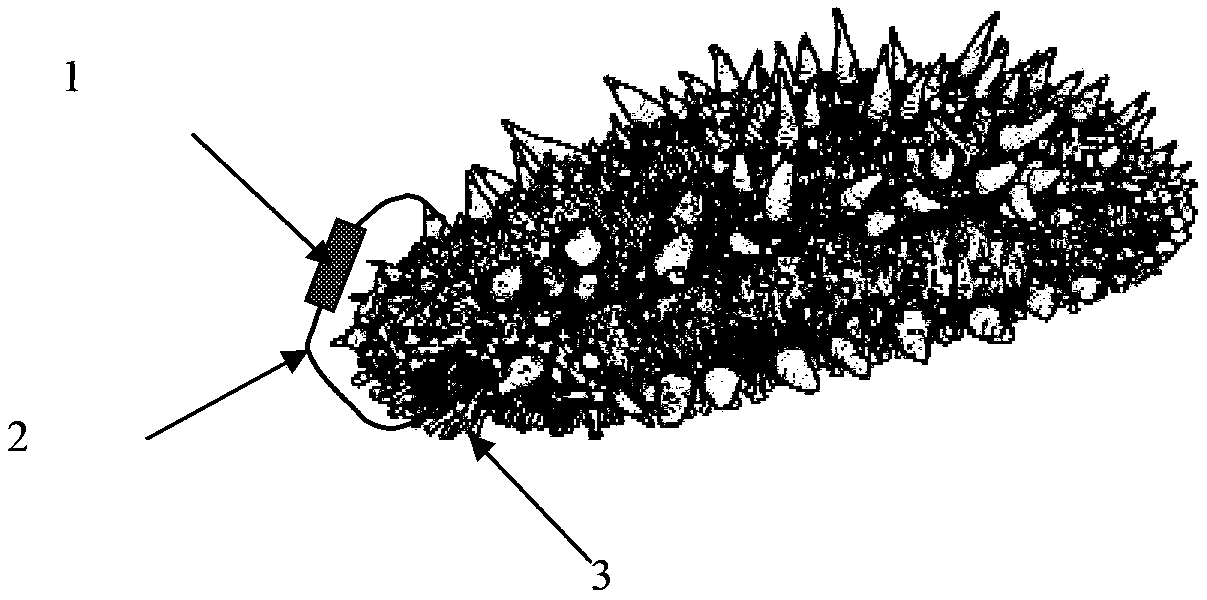In-vitro long-acting labeling method applicable to stichopus japonicus
A marking method and technology of japonicus, applied in application, climate change adaptation, fish farming, etc., can solve problems such as unidentification, and achieve the effect of wide applicability
- Summary
- Abstract
- Description
- Claims
- Application Information
AI Technical Summary
Problems solved by technology
Method used
Image
Examples
Embodiment 1
[0017] Embodiment 1: Using nylon fishing line and colored plastic labels to mark sea cucumbers
[0018] A nylon fishing line with a diameter of 0.16 mm was selected as the marking line, and plastic labels (weight 1 g) of different colors with a length of 8 mm were used to mark sea cucumbers weighing about 100 g. Put the label on the marking line, use an embroidery needle with a diameter of 0.35mm to penetrate from the mouth of the sea cucumber at a 45° angle to its body, pass through its lime ring and then pass through the position above its head, and insert the marking line Lead through the lime ring, then adjust the knotting position so that the distance between the thread and the sea cucumber body wall does not exceed 0.5cm, sinter the thread with an electric soldering iron, cut off the thread end, and the label installation is completed. The hanging rate of japonicus tags hung by this method is less than 10% within 3 days, and the retained tags can be kept firmly for more ...
Embodiment 2
[0019] Embodiment 2: Using monofilament polypropylene surgical sutures and PIT electronic tags to mark sea cucumbers
[0020] A monofilament polypropylene surgical suture was selected as the marking line, and a 6 mm long, 1 mm diameter PIT electronic tag (weight 2 g) and the marking line were fixed together with a small piece of plastic sleeve to mark about 100 g of sea cucumbers. Use an embroidery needle with a diameter of 0.35mm to insert the non-absorbable surgical suture from the mouth of the sea cucumber at a 45° angle to its body, pass through the lime ring, and then pass through the upper part of the head, and lead the marking line through Lime ring, then adjust the knotting position so that the line is no more than 0.5cm away from the body wall of the sea cucumber, tie the knot by hand, cut off the thread end, and the label installation is completed. The drop-out rate of japonicus tags tied by this method is less than 13% within 4 days, and the retained tags can be kep...
PUM
 Login to View More
Login to View More Abstract
Description
Claims
Application Information
 Login to View More
Login to View More - R&D
- Intellectual Property
- Life Sciences
- Materials
- Tech Scout
- Unparalleled Data Quality
- Higher Quality Content
- 60% Fewer Hallucinations
Browse by: Latest US Patents, China's latest patents, Technical Efficacy Thesaurus, Application Domain, Technology Topic, Popular Technical Reports.
© 2025 PatSnap. All rights reserved.Legal|Privacy policy|Modern Slavery Act Transparency Statement|Sitemap|About US| Contact US: help@patsnap.com

